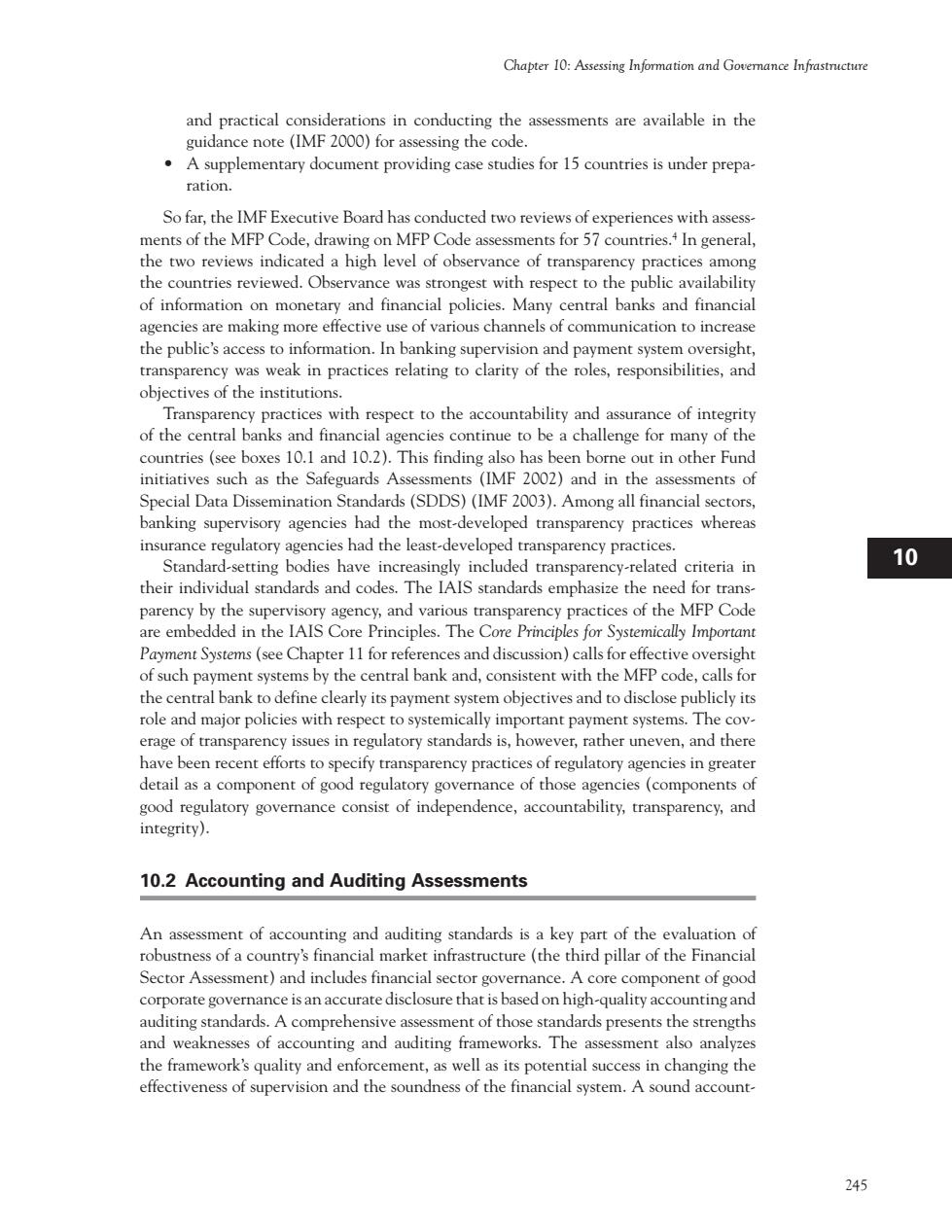正在加载图片...

Chapter 10:Assessing Information and Govemance tions in conducting the assesments are available in the .A supplementary document providing case studies for 15 countries is under prepa- ration. So far,the IMF Executive Board has conducted two reviews of experiences with assess ments of the MFP Code,drawing on MFP Code assessments for 57 countries.In general the two reviews indicated a high level of observance of transparency practices among the countries reviewed.Observance was strongest with respect to the public availability of information on monetary and financial policies.Many central banks and financial ncies are making of va ous channels of the public's acce In bar nking su rvision ar d pa yment syste in practices relating to clarity of the roles,responsibilities,an ransparency practic es with respect to the accountability an assurance of integrity of the central banks and financial agencies continue to be a challenge for many of the countries (see boxes 10.1 and 10.2).This finding also has been borne out in other Fund initiatives such as the Safeguards Assessments (IMF 2002)and in the assessments of Special Data Dissemination Standards(SDDS)(IMF 2003).Among all financial sectors banking supervisory agencies had the most-developed transparency practices whereas insurance regulatory ag gencies had the least-developed transparency practices. Standard-setting bodies have increasingly includedt y-related criteria in 10 their individual st ndards and codes.The lAIS standards emphasize the need for trans supr AIS C The Cr of the MFP Payment Systems (see Chapter 11 for ref ces and discussion) or en cave oversigh of such payment systems by the central bank and,consistent with the MFP code,calls for the central bank to define clearly its payment system objectives and to disclose publicly its role and major policies with respect to systemically important payment systems.The cov erage of transparency issues in regulatory standards is,however,rather uneven,and there have been recent efforts to specify transparency practices of regulatory agencies in greater detail as a component of good regulatory governance of those agencies(components of good regulatory governance consist of independence,accountability,transparency,and integrity). 10.2 Accounting and Auditing Assessments of accounting and auditing standards isa key t of the evaluation of ntry's fi market infr cture(th pillar of the Fin cia vernance core component of go corporate governance is an accurate disclosure that is based on high-quality acc ounting an auditing standards.A comprehensive assessment of those standards presents the strengths and weaknesses of accounting and auditing frameworks.The assessment also analyzes the framework's quality and enforcement,as well as its potential success in changing the effectiveness of supervision and the soundness of the financial system.A sound account- 245245 Chapter 10: Assessing Information and Governance Infrastructure 1 I H G F E D C B A 12 11 10 9 8 7 6 5 4 3 2 and practical considerations in conducting the assessments are available in the guidance note (IMF 2000) for assessing the code. • A supplementary document providing case studies for 15 countries is under preparation. So far, the IMF Executive Board has conducted two reviews of experiences with assessments of the MFP Code, drawing on MFP Code assessments for 57 countries.4 In general, the two reviews indicated a high level of observance of transparency practices among the countries reviewed. Observance was strongest with respect to the public availability of information on monetary and financial policies. Many central banks and financial agencies are making more effective use of various channels of communication to increase the public’s access to information. In banking supervision and payment system oversight, transparency was weak in practices relating to clarity of the roles, responsibilities, and objectives of the institutions. Transparency practices with respect to the accountability and assurance of integrity of the central banks and financial agencies continue to be a challenge for many of the countries (see boxes 10.1 and 10.2). This finding also has been borne out in other Fund initiatives such as the Safeguards Assessments (IMF 2002) and in the assessments of Special Data Dissemination Standards (SDDS) (IMF 2003). Among all financial sectors, banking supervisory agencies had the most-developed transparency practices whereas insurance regulatory agencies had the least-developed transparency practices. Standard-setting bodies have increasingly included transparency-related criteria in their individual standards and codes. The IAIS standards emphasize the need for transparency by the supervisory agency, and various transparency practices of the MFP Code are embedded in the IAIS Core Principles. The Core Principles for Systemically Important Payment Systems (see Chapter 11 for references and discussion) calls for effective oversight of such payment systems by the central bank and, consistent with the MFP code, calls for the central bank to define clearly its payment system objectives and to disclose publicly its role and major policies with respect to systemically important payment systems. The coverage of transparency issues in regulatory standards is, however, rather uneven, and there have been recent efforts to specify transparency practices of regulatory agencies in greater detail as a component of good regulatory governance of those agencies (components of good regulatory governance consist of independence, accountability, transparency, and integrity). 10.2 Accounting and Auditing Assessments An assessment of accounting and auditing standards is a key part of the evaluation of robustness of a country’s financial market infrastructure (the third pillar of the Financial Sector Assessment) and includes financial sector governance. A core component of good corporate governance is an accurate disclosure that is based on high-quality accounting and auditing standards. A comprehensive assessment of those standards presents the strengths and weaknesses of accounting and auditing frameworks. The assessment also analyzes the framework’s quality and enforcement, as well as its potential success in changing the effectiveness of supervision and the soundness of the financial system. A sound account-